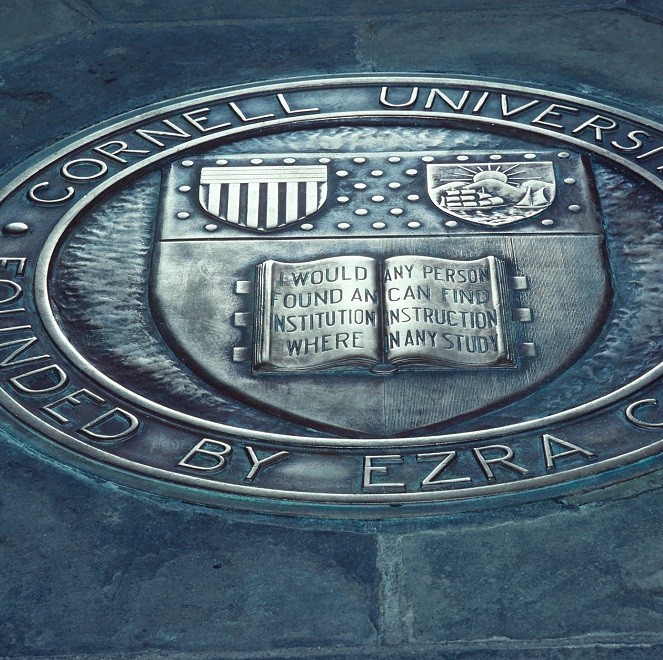News and Events
Full listing
June 2, 2021
Water regulation in leaves is vital to a plant’s health, affecting its growth and yield, disease susceptibility and drought resistance.
A breakthrough technology developed by Cornell researchers uses nanoscale sensors and fiber optics to measure water status just inside a leaf’s surface, where water in plants is most actively managed.
The engineering feat provides a minimally invasive research tool that will greatly advance the understanding of basic plant biology, and opens the door for breeding more drought-resistant crops. The technology could eventually be adapted for use as an agronomic tool for measuring water status in crops in real time.
May 27, 2021
The Cornell China Center (CCC) has announced six new grant awards, totaling $140,000, to support research by Cornell faculty teams partnering with researchers in China.
Focused on building solutions to meet the United Nations’ sustainable development goals for China and the world, the 2021 awards include four joint seed fund grants to expand collaborations between Cornell researchers and counterparts at Zhejiang University in Hangzhou and two China Innovation Grants.
May 25, 2021
First came the Big Bang. And in the moments afterward? Some physicists believe this so-called inflationary epoch was punctuated by phase transitions in which states of matter underwent significant changes.
One potential model for understanding these transitions is superfluid helium-3. That’s because helium-3 remains a liquid down to absolute zero, or minus 459.67 degrees Fahrenheit. At a few thousandths of a degree above absolute zero, it transforms to its superfluid state and flows without resistance. As a superfluid, it is a pure, clean system – like the very stuff that birthed the universe.
A Cornell-led collaboration identified an unusual behavior of superfluid helium-3 when it undergoes a phase transition between two different superfluid states – a transition that theoretically shouldn’t happen reliably. If the transition doesn’t occur where thermodynamics dictate, then the system is in a “supercooled” state. By varying the pressure of the system while lowering the temperature, the researchers caused the superfluid to transition at even lower limits, enhancing its supercooling. This display of pressure, or path, dependence has never been explored in helium and is entirely unexpected.
May 20, 2021
May 2021: A research team led by KIC co-director David Muller has beaten their previous world record for resolution by a factor of two by using an electron microscope pixel array detector (EMPAD) that incorporates even more sophisticated 3D reconstruction algorithms to locate individual atoms in all three dimensions when they might be otherwise hidden using other imaging methods.
May 20, 2021
An interdisciplinary team of Cornell researchers has taken its breakthrough discovery – which melded the ability of soft organic materials to spontaneously self-organize with quantum materials to create superconductors with novel porous architectures – and upped the ante by designing a new cohort of these “quantum metamaterials” that can achieve superconductivity at temperatures competitive with state-of-the-art solid-state materials synthesis.
In the process, they’ve demonstrated the intrinsic superconducting properties are a function of the architecture itself.
May 18, 2021
How might artificial intelligence (AI) be harnessed to propel discovery not only in the sciences, but in politics and poetics as well? Could novel chemistry enhance our ability to capture and reuse carbon? And how could archaeology of an Ithaca church combine with creative writing and 3D computer models to illuminate the experience of traveling the Underground Railroad?
The College of Arts and Sciences (A&S) has awarded 14 New Frontier Grants totaling nearly $2 million to faculty members pursuing research projects ranging from the physics of quantum computing to the design of new musical instruments; from machine-learning-enabled studies of Parkinson’s disease to the politics of the rural-urban divide.
March 17, 2021
March 2021: A collaboration led by KIC co-director Paul McEuen and KIC faculty member Itai Cohen have created micron-sized shape memory actuators that enable atomically thin two-dimensional materials to fold themselves into 3D configurations. As a demonstration, the team created what is potentially the world’s smallest self-folding origami bird.
March 11, 2021
Catalyzed by a Cornell Atkinson Center for Sustainability grant and prompted by other Cornell eco-friendly research over the past decade like the Cornell Fuel Cell Institute and the university’s Energy Materials Center, the Standard Hydrogen Corporation (SHC) and National Grid announced plans March 11 to build the first hydrogen “energy station” of its kind in the nation.
The SHC Energy Transfer System will be built in New York’s Capital Region; completion is expected by late 2022.
Pending regulatory approval, the facility will be the first demonstration of Standard Hydrogen’s innovative, multi-use, renewable hydrogen-based energy storage/delivery system. It will be available to fill fuel cell-powered automobiles with carbon-free energy, while also fulfilling other energy needs.
February 19, 2021
Cornell scientists have identified a new contender when it comes to quantum materials for computing and low-temperature electronics.
Using nitride-based materials, the researchers created a material structure that simultaneously exhibits superconductivity – in which electrical resistance vanishes completely – and the quantum Hall effect, which produces resistance with extreme precision when a magnetic field is applied.
February 18, 2021
A new study identifies a mechanism that makes bacteria tolerant to penicillin and related antibiotics, findings that could lead to new therapies that boost the effectiveness of these treatments.
Antibiotic tolerance is the ability of bacteria to survive exposure to antibiotics, in contrast to antibiotic resistance, when bacteria actually grow in the presence of antibiotics. Tolerant bacteria can lead to infections that persist after treatment and may develop into resistance over time.
The study in mice, “A Multifaceted Cellular Damage Repair and Prevention Pathway Promotes High Level Tolerance to Beta-lactam Antibiotics,” published Feb. 3 in the journal EMBO Reports, reveals how tolerance occurs, thanks to a system that mitigates iron toxicity in bacteria that have been exposed to penicillin.

